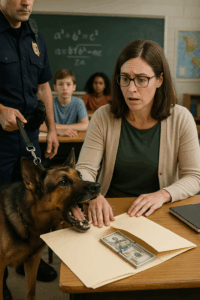Backpacks swinging, shoes squeaking on waxed floors, and cheerful chatter of youngsters running to their classrooms characterized most Meadowbrook Elementary mornings. The hallway paintings shone on this Wednesday as sunshine spilled through towering windows. School enthusiasm was high during Safety Week.
Warm-hearted Officer Cane, with graying hair and laugh wrinkles around his eyes, came with Ranger, his retired K-9. Ranger and Officer Cane visited schools to educate youngsters about safety, bravery, and the enduring link between a handler and his dog after stopping hunting criminals.
The pupils loved Ranger. He was calm, loyal, and had lovely eyes that made even the shyest youngster feel secure. This morning should be pleasant, instructive, and uneventful like the others.
However, it was not.
When Officer Cane and Ranger entered the second-grade classroom, something shifted. Lightheartedness faded. Ranger, riding quietly with his comrade, froze.
He pointed his ears forward. His posture tensed. Once, his nose twitched. Twice.
Then he barked.
One powerful bark hushed the room.
Twenty-four second-graders halt mid-giggle, mid-wiggle and gaze. Even the class hamster froze in its plastic wheel.
Target of Ranger bark?
Second-grade teacher Miss Clara Langston—the red cardiganed favorite. She has lovely blue eyes, a honeyed voice, and a knack for making every youngster feel unique. Kindness filled her classroom. She remembered anniversaries, mended knees, and provided extra food for forgetful youngsters.
Why was the dog barking at her?
She blinked, uncomfortably smiled, and returned to her work.
Ranger continued.
Barked again. Alternatively, lower, more urgent. A snarl crept into his voice. Stone-like paws anchored to the floor. He didn’t blink. He considered her a silent ticking clock.
Officer Cane frowned.
He murmured, “Easy, Ranger,” kneeling somewhat. But the dog didn’t relax.
He gently pulled the leash. Nothing.
Ranger didn’t respond to noise, play, or turmoil. His reaction was to her.
The Miss Langston grin faded. Her normally elegant hands shook noticeably.
Children moved in their chairs. Some stared at each other in confusion. Little child whispered, “Is he mad at Miss Langston?”
Then Principal Martins entered.
“Everything alright here?” he questioned, surveying the tension.
“Officer Cane,” he said, “maybe it’s best to remove the dog. He scares kids.”
Officer Cane did not approach the door.
He approached Miss Langston.
With a hushed voice, he asked, “Ma’am… Can I peek in your bag?
The rhythm passed. And another.
Colorless Miss Langston’s face.
“My bag?” She asked whispering.
One more bark from Ranger. However, his attention wandered to a folder on her desk.
Head turned, Cane. He carefully moved over, grabbed the folder, and opened it.
He stopped.
Classroom air was freezing.
They had pages of illustrations. Childlike crayoned. Red circles indicate body outline.
Neat adult-written notes.
No math issues. Not art.
Something else.
Cane maintained silence. It wasn’t necessary.
“These aren’t standard class materials,” he whispered. “From where did these come?”
When Miss Langston opened her eyes, tears were already forming.

“I thought I was helping,” she continued, her voice creaking. This article describes how children may convey emotional distress via body mapping. I believed that providing outlines and letting people express their thoughts would help identify those who needed assistance.
“You’re not a licensed counselor,” Cane remarked softly.
“No,” she muttered. “I just… I wanted to be more than a worksheet instructor. To safeguard them. Stop anything awful from beginning.”
He didn’t blame. He didn’t arrest. His nod was simple.
But the line was crossed.
No parental consent. No school psychologist supervision. Not documented.
Silent, hidden data collecting in a crimson folder on her desk.
Miss Langston was taken to the principal’s office within an hour. Her puzzled, tearful pupils went to recess early. Officer Cane kindly told the workers what transpired.
“I don’t think she meant harm,” he told the principal, “but intentions don’t erase boundaries.”
Called parents. There were meetings.
Reactions varied greatly.
A few were outraged. “She was spying on our children!” one parent shouted.
Some were heartbroken. “She was trying to help,” a mother cried. “She was the only one who noticed my son was bullied.”
Miss Langston was suspended till inquiry.
Although the school found no criminal intent, she quietly quit weeks later. No press release. Headlines absent. A gentle departure from a place she previously belonged.
Nearby districts heard rumors. Her name, once cherished, became a warning.
“She lost her husband last year,” a retired teacher told a board meeting. “I believe she was seeking a new purpose. She failed to distinguish between aiding and controlling.”
Clara relocated out of state by winter.
But Ranger remained.
He returned to schools with Officer Cane to teach new kids safety, awareness, and trust.
Officer Cane told them at every assembly:
Never doubt your intuition. Listen if a nice dog like Ranger barks.”
Even when folks overlook signals, dogs may not.
And Ranger?
He never barked randomly.
A former student of Miss Langston’s stepped onstage for his high school graduation years later. Paused in his valedictorian address.
“I want to thank all my teachers,” he remarked. Even those who remained briefly. Some viewed us in ways we didn’t comprehend. Some cared too much. They made us feel seen.”
His voice shook.
“One of them taught me to express my emotions via drawing while unable to speak. That changed everything.”
No Ranger heard it.
Old dog knew, possibly laid out beneath Officer Cane’s front porch, eyes keen and ears constantly listening.
Had done his job.


